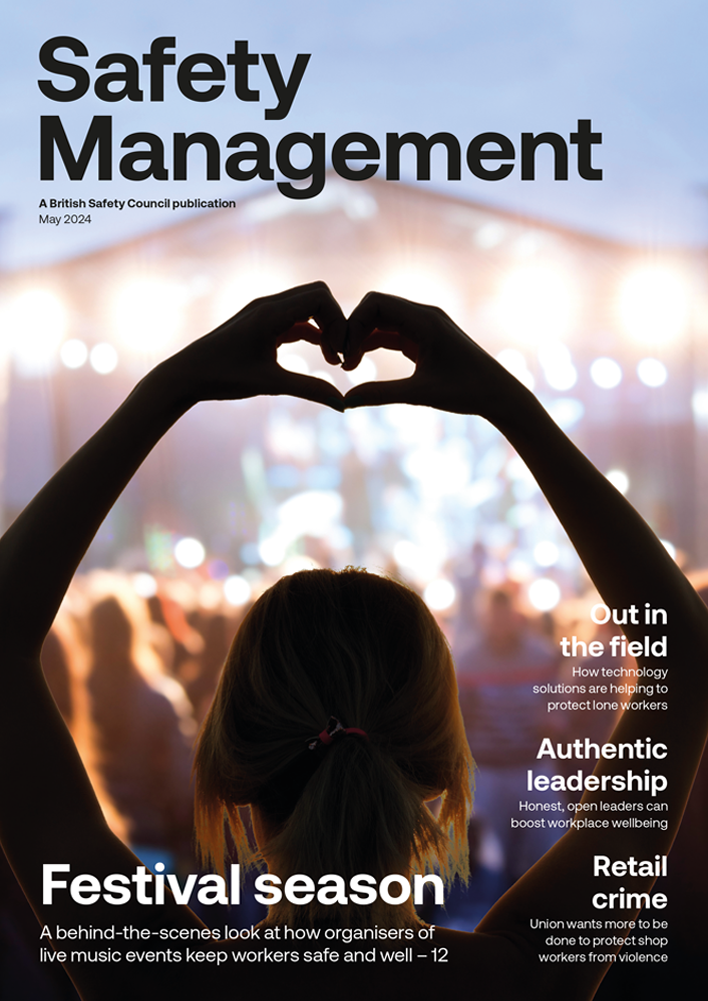I suffered a devastating but entirely preventable fall from height accident, and I believe it’s within the power of all employers and workers to do much more to prevent them.
Features
Falls from height: it’s time we stopped them
My name is Dylan Skelhorn and I suffered a life-changing accident in June 2011 due to a fall from height.
At the time, I was working as a solid fuel heating engineer for a small company that specialised in chimneys and roofing. On the first day with the company, I was sent out with the foreman to do roof repairs. After being told to climb a ladder, I asked the foreman to foot the ladder for me as the ground was uneven, but I was quickly told that “we do not foot ladders here because the boss is not going to pay someone to stand at the bottom of a ladder when that person could be on another job and earning him [the boss] more money”.
I had been a firefighter for six years previously and hearing this shocked me as I had always acted as safely as possible when working at height and the correct use of ladders was very important in the fire service. We always had our ladders secured by someone else footing them at all times – putting their foot on the bottom rung to prevent the ladder moving or slipping and holding the ladder’s stiles to ensure the ladder stayed in the correct position.
Gut feeling
After the first day with this company, I was sent out on my own to jobs and most of them involved climbing ladders to work on roofs. While climbing these ladders, sometimes I would feel the ladder move beneath me if the ground was uneven or slippery. This scared me and I used to get a gut feeling in my stomach, a ‘sixth sense’ if you like and a voice in my head telling me that this was wrong and unsafe. I had also had many near misses while on roofs from slipping but had managed to stop myself falling by quickly grabbing onto the roof ladder.
I was worried by this, so I asked my employer for a safety harness and someone to foot my ladder when I was climbing it as I didn’t feel safe working this way. I was quickly told the same thing the foreman had previously told me about how having a second person footing the ladder would cost the company money. I was also told that I wouldn’t be provided with a safety harness and that the company had a special dispensation from the Health and Safety Executive (HSE) that allowed its employees to work at height without safety harnesses because most of our work was ‘short duration’ therefore we were exempt.
 Dylan Skelhorn gives talks to inspire others to work safely at height. Photograph: Safety Up and Dylan Skelhorn
Dylan Skelhorn gives talks to inspire others to work safely at height. Photograph: Safety Up and Dylan Skelhorn
As soon as I heard this, the gut feeling and voice in my head immediately appeared again, warning me that this wasn’t true. I asked to see this so-called dispensation and was told that it was in the office but I wasn’t allowed to see it and if I wasn’t happy, I knew where the door was. Deep down, I knew that working in this way was wrong and unsafe but in the back of my mind I also thought that I needed a job to make money and pay the bills. There had just been a recession in the UK the year before and jobs were scarce, especially doing the job I did and in the area where I lived. This is no excuse and I should have put my safety first but hindsight, as they say, is a wonderful thing.
I didn’t just take the situation lying down – I did question how we were working and the available safety equipment. But at the time, I thought that I couldn’t just walk out of the door – though clearly with hindsight I could and should have. I was thinking about paying bills but when I had the accident, I couldn’t pay those bills and to this day, some of those bills have never been paid so what was I risking my life for? Nothing!
If I could go back in time to that day when I was told that I wasn’t getting the safety harness or wasn’t allowed to have someone footing the ladder, I would walk out of the job. I may have been late paying those bills due to not having a job for a few months but I would have found another job, paid those bills eventually and paid them safely and wouldn’t now be living with the consequences of a serious life-changing accident for the rest of my life.
Although I had eventually spoken up about safety I didn’t act on my worries and words when I was shot down and given that ultimatum – ‘work unsafely or there’s the door’. If I had really listened to myself and acted on my concerns and words I would have walked out of the door and the accident would never have happened. So there is a lesson here for anyone concerned about safety at work: always act on your words when you spot or raise a safety concern – go with your gut feeling and never ignore the warning signs.
One of the many annoying parts of what led up to the accident for me is the fact that I had made a plan to leave the job during the summer holidays. The company used to close for three weeks for summer so I planned to use this time to seek new employment and leave the job. The summer holidays were only six weeks away and I thought that if I could just make it safely to then, I’d never have to work unsafely again because I’d look for a job with a bigger, safer company that would give me the correct personal protective and safety equipment. This was my escape plan.
I now realise that safety is not something to do in six weeks’ time, six minutes’ or even six seconds’ time – it’s right now, all the time, and it never stops or switches off. Don’t be safe just because the rules tell you to – be safe for you, your family, friends, colleagues, hobbies, etc. Because when you have an accident, you are not the only person to suffer or be affected by it. There is a huge knock-on effect on all the people close to you and it affects many parts of your life.
Day of the accident
On the day of my accident, 20 June 2011, it was a Monday morning and I came into work expecting to be doing the usual chimney work I carried out, such as re-lining and rebuilding chimneys, fitting stoves and fireplaces. This was what I did most days and I suppose I became complacent by doing the same kind of work every day and setting my sights on a few weeks’ time when I could finally leave the job and work safely in the future. This was not to be. When I arrived at work, I was told that one of the chimney sweeps had phoned in sick and I was to go and do his job with another colleague as we were short staffed.
I had around 10 chimney sweeps to do that day with my colleague and everything seemed to be going fine. After lunch we arrived at the next job in a small village called California in Falkirk, Scotland. I set up my ladders, climbed them and went on to the chimney stack to sweep it. My colleague had entered the house to sheet up the fireplace to protect the room from soot fall. This is the way we were told to work, operating without safety harnesses.
However, HSE later investigated my accident and concluded that this was not the correct way to sweep a chimney. While I was standing on the chimney stack, it collapsed into around four pieces and I fell 33 feet and landed on a garden wall. I suffered two broken ribs which then punctured my right lung and both sides of my pelvis snapped due to the way I landed. I almost died at the scene due to choking on blood from my lung but was fortunate that the ambulance was close by and arrived relatively quickly. This is just pure luck and I was told that if the ambulance had been required to travel from the ambulance depot that day, I probably wouldn’t have survived.
The paramedics worked on me in the garden for about 45 minutes and managed to save my life. In the ambulance on the way to hospital, I was thinking, ‘Why didn’t I listen to that gut feeling and the voice in my head?’ My bladder was punctured by mistake in the emergency room due to a catheter being inserted incorrectly – another knock-on effect of the accident. This still causes me chronic pain every day and will do for the rest of my life.
Now partially disabled
I am now classed as 40 per cent disabled with degenerative arthritis in my pelvis and lower back. I can no longer go to the gym, which I loved doing and had done three or four times a week for the previous 14 years before my accident. My girlfriend left me due to the accident and this is very common because the people around you suffer as well after an accident. It’s not that partners and family members don’t care – they just can’t handle it and aren’t prepared for it. They go through everything that you do, except for the physical pain.
 The medication Dylan Skelhorn takes to manage the long-term pain from his injuries. Photograph: Safety Up and Dylan Skelhorn
The medication Dylan Skelhorn takes to manage the long-term pain from his injuries. Photograph: Safety Up and Dylan Skelhorn
My family have been affected in ways that you could never imagine. After the accident, my employer gave me a fake dispensation based on the one he had previously told me about to try and convince me that the accident was my fault. I showed this to HSE and they assured me that nobody gets permission to work at height without fall arrest equipment, whether that be collective or personal, so my gut feeling was correct. I then found out that my employer had done this to two other people before I joined the company. These people had suffered falls from around the same height as mine, which led to life-changing injuries and neither of those accidents were reported so he was able to continue risking people’s lives.
My employer was eventually fined £20,000 at court in November 2013 for my accident and had decided to close his business before the court hearing, so around eight of my colleagues lost their jobs. So this was another knock-on effect of the accident – but on others. I received compensation for my injuries in January 2014 but the money never makes up for everything you lose after an accident. I knew I was never going to be able to work physically again, which is all I had done since leaving school, but I passionately wanted to prevent this happening to other people so I decided to become a motivational safety speaker to share my story. On 20 June 2014 (three years to the day after the accident) I started my business – Safety Up.
I get a lot of satisfaction from my job and great comments and feedback. As I approach my 10th year in business, I have probably spoken to hundreds of thousands of people in hundreds, if not thousands of companies across the globe.
Duty of care
I believe that all employers have a duty of care towards their employees to allow them to work at height safely. There is not only a legal duty but also a moral duty. If a company does not allow you to work at height safely then they are not worth working for and have no respect for you. Safety is a two-way thing; it’s a mutual respect. Why should you come to work and risk your life every day for a company that does not care about you? I made that mistake.
However, the responsibility works both ways and every employee also has a legal and moral duty to work safely and not put themselves or anyone else in danger. As an individual, you should always look out for yourself, be your own personal safety officer and also look out for others around you. If you see someone doing something unsafe, speak up and challenge it as they might not even be aware that they are putting themselves and perhaps others at risk. You could be the one who prevents them from having the accident and being severely injured or even worse.
It doesn’t matter what position that person is in the company, the apprentice or the CEO, we all make mistakes and we’re only human. But I believe that if employers give employees the authority and empowerment to speak up and stop a dangerous job or task such as working at height when they spot a hazard, the employee is more likely to stop the job or task and prevent an accident because they know there will be no repercussions.
When I spoke up about safety, I was shot down and threatened with losing my job so I knew there was no point in speaking up again. Safety has to be led from the top by the employer who must set a good example. When working for the chimney and roofing company, I was trying to lead it from the bottom and that never works.
The companies that I visit to talk to workers and leaders about my story have good safety cultures and I think that people’s attitudes towards safe working at height have improved in recent years, but serious injuries are still occurring and work at height continues to be the biggest cause of injury-related deaths in UK workplaces. I therefore think there is still room for huge improvement and it isn’t acceptable in this day and age that people are still dying and being seriously injured due to preventable work at height accidents.
I hope that the presentations I deliver will inspire people to always work safely because hearing my story and the knock-on effect that my accident has had on others like my family hopefully brings home the terrible consequences of taking short-cuts or not speaking up about safety. In fact, it’s not really about my story – it’s too late to prevent my accident, but it’s an example of what could happen to the people who are listening to my words. My aim is always to ensure that the person listening thinks about how an accident or fall from height would affect their lives, families, children, friends, hobbies and anything or anyone in life that they love and care about. The main message is DON’T DO WHAT I DID!
As well as workers, I also believe the audience should include senior leaders as they have a huge role to play in encouraging a culture of safe working. They also need to understand the consequences for them personally if their negligence, oversight or lack of commitment to safety leads to an accident.
I am now a Safety Ambassador for a charity called the No Falls Foundation, whose aim is to prevent fall from height accidents and support victims of falls from height like myself. I would like to spread the word far and wide to let as many people know that there is help available from the charity should you ever be unfortunate enough to need it.
Ladder stabiliser device
After being told by my employer that he wasn’t going to pay someone to foot my ladder, I looked online to see if I could buy a ladder stabiliser to bring to work that would allow me to work safely on my own, but I could not find anything that actually worked safely and would prevent a ladder from moving or blowing over in a strong wind. I had an idea of what a genuinely effective stabiliser device would be required to do. It would need to prevent the ladder from moving all four possible ways that a ladder can fail, level it up on uneven ground and position it at the correct and safe angle.
Unfortunately, the accident then happened so this idea was put on hold for many years. However, in 2016, I decided to apply for worldwide patents so that I could bring this product to market and make it available to everyone and help prevent ladder accidents to lone workers. After lots of personal investment of time, money, research and development, I am now ready to launch this new product called Ladder Locker, which will be on the market in 2024. A video demonstrating the Ladder Locker can be found on YouTube.
As well as hopefully being able to inspire people to work more safely through my presentations, I also now want to be able to provide safe equipment that physically prevents work at height accidents.
Always remember – nothing is more important than going home safely to your family, friends and loved ones.
Take care and stay safe.
Dylan Skelhorn is a global safety and health motivational speaker at Safety Up.
For more information, visit: safetyup.co.uk
FEATURES

Progress made and challenges ahead – Grenfell six years on
By Aisha Farooq, Fire Protection Association (FPA) on 01 August 2023
On the sixth anniversary of the Grenfell Tower fire, 2023 has seen a significant rollout of legislative changes to fire safety in high-rise residential buildings that highlight the progress made and the challenges that yet remain.

AI and worker wellbeing: a new risk for employers
By David Sharp, International Workplace on 10 May 2024
Data generated by machine learning and artificial intelligence at work looks set to play a huge role in boosting both worker health and safety and business productivity, but it’s vital that workers’ data used for algorithmic processing is handled lawfully, fairly and transparently.

EHS software: a vital tool for improving safety at work
By Emma Bundy, Yokogawa RAP on 10 May 2024
Environmental, safety and health software can greatly improve the management of EHS risks and bring wider business efficiencies, but it’s essential to select the right system – and ensure everyone buys into its correct and full implementation.



